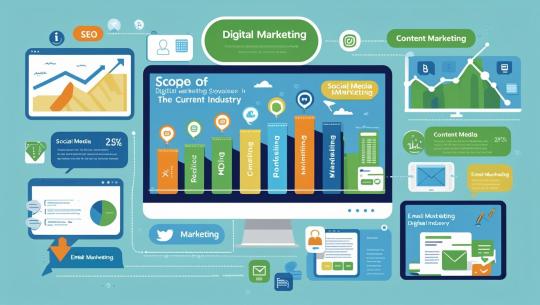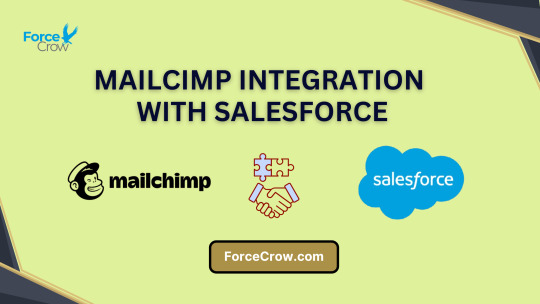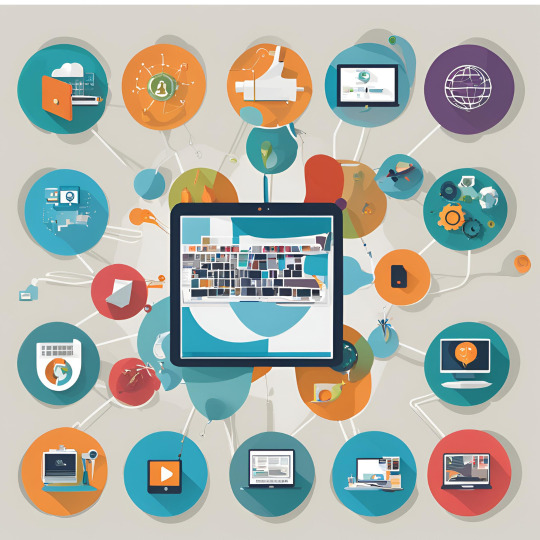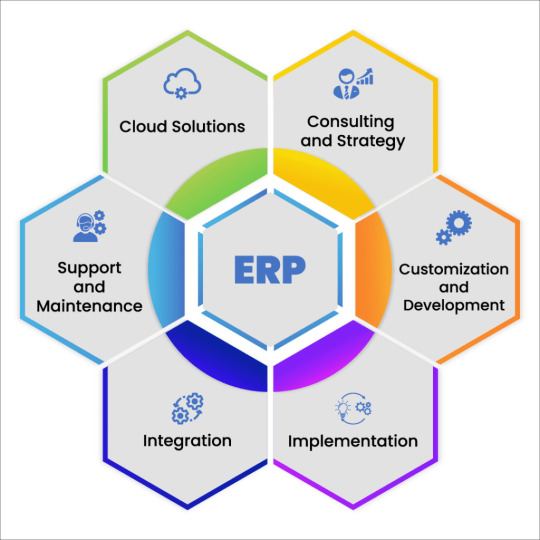#salesforce real time integration
Explore tagged Tumblr posts
Text

Unlock the full potential of your business with our expert Salesforce Integration services. As dedicated Salesforce Integration Specialists, we are committed to seamlessly connecting Salesforce with your existing systems, ensuring a unified platform that drives efficiency, enhances customer relationships, and boosts productivity. Our approach is centered around understanding your unique business needs and leveraging the power of Salesforce to create a tailored solution that integrates perfectly with your operations. From CRM to marketing automation and beyond, we ensure that every piece of your business software communicates flawlessly, providing real-time data access and enabling smarter, data-driven decisions. Trust our team to streamline your processes, reduce operational complexity, and elevate your business performance. Partner with us, your Salesforce Integration Specialists, to transform your technological landscape and achieve unparalleled success in your digital transformation journey.
#salesforce integration services#salesforce real time integration#salesforce integration specialist#salesforce data integration
0 notes
Text
Real Stories from the Salesforce Agentforce Hackathon 2025: How GetOnCRM Built Smarter Workflows
Discover how GetOnCRM’s winning solution at the Salesforce Agentforce Hackathon 2025 tackled real business challenges through intelligent workflow automation. Learn how Slack-based Salesforce Agentforce workflows, cross-cloud integrations, and real-time data are transforming internal support, DevOps, and customer service operations.
#Salesforce Agentforce Hackathon 2025#GetOnCRM Agentforce solution#Real-time Salesforce automation#Salesforce workflow consulting#Slack Salesforce integration#Salesforce Agent Builder#Salesforce automation success stories#TDX 2025 highlights#Cross-cloud Salesforce workflows#Intelligent Salesforce bots
0 notes
Text
🔗 Seamlessly Connect Your Systems with Salesforce Integration Services! 🌐
Struggling to sync your Salesforce CRM with other tools and platforms? Salesforce Integration Services ensure that all your business systems—from ERP to marketing automation—work together seamlessly! Streamline your operations, boost data accuracy, and unlock new efficiencies. Dextara Datamatics
✅ Effortless Data Sync ✅ Enhanced Workflow Automation ✅ Custom API Integrations ✅ Real-Time Insights Across Platforms
Integrate smarter and accelerate your business success! 🚀💼
#salesforce consultant#salesforce consulting services#boost data accuracy#and unlock new efficiencies.#✅ Effortless Data Sync#✅ Enhanced Workflow Automation#✅ Custom API Integrations#✅ Real-Time Insights Across Platforms#Integrate smarter and accelerate your business success! 🚀💼#Salesforce#DigitalTransformation#BusinessEfficiency#CRM#DataSync
0 notes
Text
Axolt: Modern ERP and Inventory Software Built on Salesforce
Today’s businesses operate in a fast-paced, data-driven environment where efficiency, accuracy, and agility are key to staying competitive. Legacy systems and disconnected software tools can no longer meet the evolving demands of modern enterprises. That’s why companies across industries are turning to Axolt, a next-generation solution offering intelligent inventory software and a full-fledged ERP on Salesforce.
Axolt is a unified, cloud-based ERP system built natively on the Salesforce platform. It provides a modular, scalable framework that allows organizations to manage operations from inventory and logistics to finance, manufacturing, and compliance—all in one place.
Where most ERPs are either too rigid or require costly integrations, Axolt is designed for flexibility. It empowers teams with real-time data, reduces manual work, and improves cross-functional collaboration. With Salesforce as the foundation, users benefit from enterprise-grade security, automation, and mobile access without needing separate platforms for CRM and ERP.
Smarter Inventory Software Inventory is at the heart of operational performance. Poor inventory control can result in stockouts, over-purchasing, and missed opportunities. Axolt’s built-in inventory software addresses these issues by providing real-time visibility into stock levels, warehouse locations, and product movement.
Whether managing serialized products, batches, or kits, the system tracks every item with precision. It supports barcode scanning, lot and serial traceability, expiry tracking, and multi-warehouse inventory—all from a central dashboard.
Unlike traditional inventory tools, Axolt integrates directly with Salesforce CRM. This means your sales and service teams always have accurate availability information, enabling faster order processing and better customer communication.
A Complete Salesforce ERP Axolt isn’t just inventory software—it’s a full Salesforce ERP suite tailored for businesses that want more from their operations. Finance teams can automate billing cycles, reconcile payments, and manage cash flows with built-in modules for accounts receivable and payable. Manufacturing teams can plan production, allocate work orders, and track costs across every stage.
86 notes
·
View notes
Text
Connect Odoo with Tableau Desktop

The Techfinna Odoo Tableau Connector is a integration tool that connects Odoo with Tableau, enabling real-time data extraction and visualization. With features like custom table selection, automatic schema detection, and support for live data refresh, it simplifies the process of creating dynamic dashboards and reports. This connector empowers businesses to unlock deeper insights and make data-driven decisions efficiently.
#odoo #odooerp #odoosoftware #odoomodule #crm #accounting #salesforce #connector #integration #odoo18 #odoo17 #microsoft #powerbi #desktop #odoo services#odooimplementation#google#odoo development company#odoo crm#microsoft#odoo erp#odoo#good omens
#odoo erp#odoo18#odooimplementation#odoo development company#odoo services#analytics#innovation#cybersecurity#tableau#advanced#odoo#business
8 notes
·
View notes
Text
Significance of digital marketing in modern industries

The scope of digital marketing in the present industry (2025) is vast and continues to expand rapidly due to technological advancements, changing consumer behavior, and the increasing dominance of online platforms. Here's a breakdown of its current scope and relevance:
🔍 1. Widespread Industry Adoption Almost every industry—from retail and finance to healthcare and education—is leveraging digital marketing to reach customers. Key sectors include:
E-commerce (e.g., Amazon, Flipkart)
EdTech (e.g., Byju’s, Coursera)
FinTech (e.g., Paytm, Razorpay)
Real Estate
Healthcare
Tourism and Hospitality
📈 2. Core Areas of Digital Marketing Digital marketing encompasses a range of strategies and platforms:
Search Engine Optimization (SEO)
Search Engine Marketing (SEM)
Social Media Marketing (SMM) – Using platforms like Instagram, Facebook, LinkedIn, TikTok, and X
Content Marketing – Blogs, videos, infographics, podcasts
Email Marketing – Personalized outreach and lead nurturing
Affiliate Marketing – Performance-based promotions through third-party partners
Influencer Marketing – Collaborations with social media influencers
Marketing Automation & CRM Tools – Tools like HubSpot, Mailchimp, and Salesforce
Analytics & Data-Driven Marketing – Using tools like Google Analytics, Hotjar, and AI-powered insights
🤖 3. Integration of Emerging Technologies AI and Machine Learning – Personalization, predictive analytics
Voice Search Optimization – With rise of Alexa, Google Assistant, Siri
AR/VR Marketing – Interactive product experiences
Video Marketing & Livestreaming – Especially on YouTube, Instagram Live, and TikTok
Web3 & Blockchain Marketing – Emerging in niche communities (NFTs, decentralized platforms)
🌎 4. Global and Local Reach Digital marketing allows for:
Global branding for startups and SMEs
Hyper-local targeting through geo-targeting, localized ads, and regional influencers
👨💼 5. Career and Business Opportunities High demand for skilled professionals – Digital marketers, SEO/SEM experts, content creators, analysts
Freelancing & remote work – Increasingly common
Entrepreneurial scope – Digital marketing agencies, affiliate marketing, dropshipping businesses
📊 6. Measurable ROI and Flexibility Real-time tracking and campaign optimization
Budget flexibility – effective even with modest ad spend
A/B testing and audience segmentation improve performance
🧠 7. Challenges & Evolving Landscape Ad fatigue and privacy concerns:
Algorithm updates affecting reach and engagement
High competition – Constant need for creativity and innovation
🔮 Conclusion: Digital marketing in 2025, t's a necessity. It offers:
Cost-effective outreach
Better targeting
Real-time feedback
High scalability
It will continue to evolve with AI, data analytics, immersive experiences, and consumer-centric personalization at the forefront.
2 notes
·
View notes
Text
Complete Guide: Asana to Salesforce Integration
Asana is one of the most widely adopted work management platforms, trusted by over 85% of Fortune 100 companies to manage team workflows. Meanwhile, Salesforce stands as a global leader in customer relationship management (CRM), empowering more than 150,000 businesses worldwide.
Although both platforms shine in their individual domains—Salesforce for CRM and Asana for task and project management—many organizations fail to recognize the true benefits of Salesforce and Asana integration. Using them in silos can limit productivity and lead to communication gaps.
If your teams rely on both platforms but haven’t integrated them yet, you could be missing out on a major opportunity to streamline processes, foster better collaboration, and accelerate your business goals. This blog explores the power of Asana to Salesforce integration, highlighting key features, benefits, and how to make the most of both platforms.
Overview of Asana and Salesforce
Asana is a flexible, intuitive project management solution designed to help teams track progress, delegate tasks, and stay aligned. It creates a centralized workspace where communication, task tracking, and project timelines are managed efficiently.
From team communication to task tracking and reporting, Asana empowers project managers to drive accountability while reducing inefficiencies and delays.
Salesforce, on the other hand, is a leading cloud-based CRM platform built for businesses of all sizes. It unites marketing, sales, and customer service efforts under one roof. Its powerful tools streamline lead management, automate workflows, and provide a 360-degree view of the customer journey.
Key Features of Asana
1. Communication Tools Asana fosters effective communication across teams. With built-in comment threads, task discussions, and image feedback features, teams can communicate clearly and act on tasks directly. Managers can post updates using rich-text fields, improving clarity.
Asana supports global teams with multi-language support including English, Spanish, German, Italian, and more. Meanwhile, Salesforce also enhances communication by offering a unified platform for customer and internal interactions.
2. Work Management Capabilities From subtasks to timelines, dependencies to custom fields—Asana covers it all. Its task structuring features ensure that nothing falls through the cracks. Pre-built templates and task approvals also help teams launch and manage projects with ease.
3. Reporting Tools Asana offers robust dashboards and real-time project tracking. Teams can align daily tasks with company-wide goals, while stakeholders stay informed with live status updates and exportable reports.
4. Team Collaboration and Control Asana enables seamless team collaboration through shared calendars, access permissions, and real-time updates. Whether you want to keep a project private or accessible to your full team, Asana’s controls give you the flexibility you need. Its real-time dashboards offer at-a-glance insights into project health—making it easier to catch delays before they become problems.
5. Easy Integration with Existing Apps Asana connects with over 300 popular apps, including Google Drive, Slack, Microsoft Teams, and more. This makes it a flexible solution that complements your existing tech stack without disrupting workflow.
Benefits of Asana to Salesforce Integration
Integrating Asana with Salesforce enhances workflow visibility and aligns customer-facing and project execution teams. Here's how your business can benefit:
1. Smoother Post-Sales Processes Once a deal is closed in Salesforce, teams can automatically trigger onboarding workflows in Asana. Attachments, notes, and tasks can be shared instantly between customer success and service teams, reducing handoff friction. Templates in Asana help create consistent onboarding experiences, and Salesforce Service Cloud connects teams from pre-sale to delivery.
2. Workflow Automation via Flow Builder Salesforce Flow Builder allows you to automate routine tasks in Asana, reducing manual errors and ensuring important steps aren’t missed. Automation between the platforms keeps both systems synchronized and ensures real-time updates. This not only improves efficiency but also enhances data accuracy between teams.
3. Visibility Into Business Goals With the integration, your Salesforce data can be tied to Asana goals—enabling better decision-making and transparency. As deals move through the pipeline, teams get visibility into how individual tasks impact larger objectives.
4. Better Cross-Team Alignment The integration breaks down silos between departments. Marketing, sales, and service teams can view the status of tasks, upcoming deadlines, and customer-specific projects in real time—reducing miscommunication and delays.
Final Thoughts
The Asana to Salesforce integration enables your teams to do more with less effort—automating routine work, reducing data errors, and bridging gaps between departments. If you're looking to boost productivity and collaboration, now is the time to act. 👉 Choose MultiSync Made Easy — the best tool to integrate Asana with Salesforce seamlessly.
2 notes
·
View notes
Video
youtube
How to Integrate Salesforce Cases to Jira Work Types and Sync Custom Fields using Exalate’s AI Assist
Struggling to keep your teams on the same page? Connecting your Salesforce and Jira instances can transform how your customer support, IT, and development teams work together, making collaboration smoother and more efficient.
With a two-way integration powered by Exalate’s AI Assist, syncing Salesforce cases with Jira work types becomes easier.
Just tell AI Assist your sync requirements in plain language, and it generates the sync scripts for you, whether your needs are simple or complex.
Whether you want to automatically track customer feedback, incidents, or get real-time status updates, syncing Salesforce and Jira ensures consistent data and speeds up your workflows.
Here’s what you’ll learn in this video:
Automatically create Salesforce Cases as Jira Stories
Use AI Assist to map Salesforce Cases to Jira Incidents [work types]
Sync Salesforce Case numbers to Jira custom fields and back-reference Jira ticket keys in Salesforce
Ready to unify your teams and simplify your processes?
📖 Dive into the full integration guide here.
💡 Want a tailored solution? Book a discovery call with us.
2 notes
·
View notes
Text
How to Choose the Right Tech Stack for Your Web App in 2025

In this article, you’ll learn how to confidently choose the right tech stack for your web app, avoid common mistakes, and stay future-proof. Whether you're building an MVP or scaling a SaaS platform, we’ll walk through every critical decision.
What Is a Tech Stack? (And Why It Matters More Than Ever)
Let’s not overcomplicate it. A tech stack is the combination of technologies you use to build and run a web app. It includes:
Front-end: What users see (e.g., React, Vue, Angular)
Back-end: What makes things work behind the scenes (e.g., Node.js, Django, Laravel)
Databases: Where your data lives (e.g., PostgreSQL, MongoDB, MySQL)
DevOps & Hosting: How your app is deployed and scaled (e.g., Docker, AWS, Vercel)
Why it matters: The wrong stack leads to poor performance, higher development costs, and scaling issues. The right stack supports speed, security, scalability, and a better developer experience.
Step 1: Define Your Web App’s Core Purpose
Before choosing tools, define the problem your app solves.
Is it data-heavy like an analytics dashboard?
Real-time focused, like a messaging or collaboration app?
Mobile-first, for customers on the go?
AI-driven, using machine learning in workflows?
Example: If you're building a streaming app, you need a tech stack optimized for media delivery, latency, and concurrent user handling.
Need help defining your app’s vision? Bluell AB’s Web Development service can guide you from idea to architecture.
Step 2: Consider Scalability from Day One
Most startups make the mistake of only thinking about MVP speed. But scaling problems can cost you down the line.
Here’s what to keep in mind:
Stateless architecture supports horizontal scaling
Choose microservices or modular monoliths based on team size and scope
Go for asynchronous processing (e.g., Node.js, Python Celery)
Use CDNs and caching for frontend optimization
A poorly optimized stack can increase infrastructure costs by 30–50% during scale. So, choose a stack that lets you scale without rewriting everything.
Step 3: Think Developer Availability & Community
Great tech means nothing if you can’t find people who can use it well.
Ask yourself:
Are there enough developers skilled in this tech?
Is the community strong and active?
Are there plenty of open-source tools and integrations?
Example: Choosing Go or Elixir might give you performance gains, but hiring developers can be tough compared to React or Node.js ecosystems.
Step 4: Match the Stack with the Right Architecture Pattern
Do you need:
A Monolithic app? Best for MVPs and small teams.
A Microservices architecture? Ideal for large-scale SaaS platforms.
A Serverless model? Great for event-driven apps or unpredictable traffic.
Pro Tip: Don’t over-engineer. Start with a modular monolith, then migrate as you grow.
Step 5: Prioritize Speed and Performance
In 2025, user patience is non-existent. Google says 53% of mobile users leave a page that takes more than 3 seconds to load.
To ensure speed:
Use Next.js or Nuxt.js for server-side rendering
Optimize images and use lazy loading
Use Redis or Memcached for caching
Integrate CDNs like Cloudflare
Benchmark early and often. Use tools like Lighthouse, WebPageTest, and New Relic to monitor.
Step 6: Plan for Integration and APIs
Your app doesn’t live in a vacuum. Think about:
Payment gateways (Stripe, PayPal)
CRM/ERP tools (Salesforce, HubSpot)
3rd-party APIs (OpenAI, Google Maps)
Make sure your stack supports REST or GraphQL seamlessly and has robust middleware for secure integration.

Step 7: Security and Compliance First
Security can’t be an afterthought.
Use stacks that support JWT, OAuth2, and secure sessions
Make sure your database handles encryption-at-rest
Use HTTPS, rate limiting, and sanitize inputs
Data breaches cost startups an average of $3.86 million. Prevention is cheaper than reaction.
Step 8: Don’t Ignore Cost and Licensing
Open source doesn’t always mean free. Some tools have enterprise licenses, usage limits, or require premium add-ons.
Cost checklist:
Licensing (e.g., Firebase becomes costly at scale)
DevOps costs (e.g., AWS vs. DigitalOcean)
Developer productivity (fewer bugs = lower costs)
Budgeting for technology should include time to hire, cost to scale, and infrastructure support.
Step 9: Understand the Role of DevOps and CI/CD
Continuous integration and continuous deployment (CI/CD) aren’t optional anymore.
Choose a tech stack that:
Works well with GitHub Actions, GitLab CI, or Jenkins
Supports containerization with Docker and Kubernetes
Enables fast rollback and testing
This reduces downtime and lets your team iterate faster.
Step 10: Evaluate Real-World Use Cases
Here’s how popular stacks perform:

Look at what companies are using, then adapt, don’t copy blindly.
How Bluell Can Help You Make the Right Tech Choice
Choosing a tech stack isn’t just technical, it’s strategic. Bluell specializes in full-stack development and helps startups and growing companies build modern, scalable web apps. Whether you’re validating an MVP or building a SaaS product from scratch, we can help you pick the right tools from day one.
Conclusion
Think of your tech stack like choosing a foundation for a building. You don’t want to rebuild it when you’re five stories up.
Here’s a quick recap to guide your decision:
Know your app’s purpose
Plan for future growth
Prioritize developer availability and ecosystem
Don’t ignore performance, security, or cost
Lean into CI/CD and DevOps early
Make data-backed decisions, not just trendy ones
Make your tech stack work for your users, your team, and your business, not the other way around.
1 note
·
View note
Text
𝐒𝐮𝐩𝐞𝐫𝐜𝐡𝐚𝐫𝐠𝐞 𝐘𝐨𝐮𝐫 𝐌𝐚𝐫𝐤𝐞𝐭𝐢𝐧𝐠 𝐰𝐢𝐭𝐡 𝐌𝐚𝐢𝐥𝐜𝐡𝐢𝐦𝐩 + 𝐒𝐚𝐥𝐞𝐬𝐟𝐨𝐫𝐜𝐞 𝐈𝐧𝐭𝐞𝐠𝐫𝐚𝐭𝐢𝐨𝐧!
Ready to take your marketing efforts to the next level? 🌟 With Mailchimp Integration with Salesforce, you can seamlessly sync your customer data, create personalized email campaigns, and drive higher engagement! 📈✨
💡 Improve your ROI with real-time data updates, boost customer targeting, and streamline your marketing strategy effortlessly! 🎯
Want to know how? 👉 𝐂𝐥𝐢𝐜𝐤 𝐨𝐧 𝐭𝐡𝐞 𝐜𝐨𝐦𝐦𝐞𝐧𝐭𝐬 𝐛𝐞𝐥𝐨𝐰 𝐟𝐨𝐫 𝐦𝐨𝐫𝐞 𝐢𝐧𝐟𝐨! 👇

#Salesforce#Mailchimp#EmailMarketing#CRMIntegration#MarketingAutomation#CustomerEngagement#DigitalMarketing#CRM
2 notes
·
View notes
Text
Connect or integrate Odoo ERP database with Microsoft Excel

Techfinna's Odoo Excel Connector is a powerful tool that integrates Odoo data with Microsoft Excel. It enables users to pull real-time data, perform advanced analysis, and create dynamic reports directly in Excel. With its user-friendly interface and robust functionality, it simplifies complex workflows, saving time and enhancing productivity.
#odoo #odooerp #odoosoftware #odoomodule #crm #accounting #salesforce #connector #integration #odoo18 #odoo17 #erpsoftware #odoodevelopers #odoocustomization #erpimplementation #lookerstudio #odoo18 #odoo17
#odoo#odoo company#odoo erp#odoo services#odoo software#odoo web development#good omens#odoo crm#odoo development company#odoo18#microsoft#excel#ms excel#odoointegration#analytics#odoopartner#odooimplementation#innovation#business#customersatisfaction#cybersecurity
5 notes
·
View notes
Text
How BizMagnets WhatsApp Flows Empower Sales and Support Teams
Introduction
In the era of instant communication, businesses are under constant pressure to deliver seamless and efficient customer experiences. For sales and support teams, maintaining speed and precision in their interactions can be a daunting challenge, especially when managing a large customer base. BizMagnets WhatsApp Flows emerge as a game-changer, offering automation, personalization, and efficiency to streamline operations.
This blog explores how BizMagnets WhatsApp Flows empower sales and support teams to achieve their goals effortlessly, driving both productivity and customer satisfaction.
What Are WhatsApp Flows?
WhatsApp Flows are automated communication workflows designed to guide customers through predefined pathways. These flows handle repetitive tasks, provide consistent responses, and ensure customers receive timely, accurate information.
BizMagnets WhatsApp Flows take this concept further by offering advanced automation tailored to the needs of sales and support teams, enabling them to focus on what they do best—building relationships and solving problems.
Key Features of BizMagnets WhatsApp Flows
1. Customizable Workflow Builder
Easily design workflows tailored to your sales or support processes with an intuitive drag-and-drop builder.
2. AI-Powered Automation
Leverage AI to predict customer needs, suggest solutions, and guide conversations dynamically.
3. Seamless CRM Integration
Integrate WhatsApp Flows with popular CRMs like Salesforce, HubSpot, and Zoho for synchronized operations.
4. Real-Time Notifications
Keep teams updated with instant notifications about leads, escalations, or critical customer issues.
5. Performance Tracking
Analyze workflow efficiency with detailed metrics and reports.
How WhatsApp Flows Empower Sales Teams
1. Streamlining Lead Management
Automate lead qualification by asking predefined questions to gather essential information.
Instantly route qualified leads to sales agents for follow-up.
Send personalized welcome messages to new leads, making a strong first impression.
2. Accelerating Sales Cycles
Automate follow-ups with potential customers to ensure no opportunity slips through the cracks.
Share brochures, catalogs, or pricing instantly through automated responses.
Use WhatsApp Flows to send reminders for meetings, demos, or payment deadlines.
3. Personalized Customer Interactions
Craft personalized sales pitches by incorporating customer data into WhatsApp Flows.
Provide tailored product recommendations based on customer preferences and purchase history.
4. 24/7 Availability
Use automated flows to engage leads even outside of working hours.
Provide instant responses to FAQs, ensuring leads remain engaged.
5. Improved Collaboration
Notify sales teams instantly about high-priority leads.
Use WhatsApp Flows to coordinate between field sales teams and office staff.
How WhatsApp Flows Empower Support Teams
1. Faster Query Resolution
Automate responses to common queries such as account information, troubleshooting steps, or return policies.
Escalate complex issues to human agents seamlessly within the same WhatsApp thread.
2. Proactive Customer Support
Send proactive messages such as appointment reminders, payment due alerts, or service updates.
Conduct satisfaction surveys after resolving issues to gather actionable feedback.
3. Reducing Workload for Agents
Handle high volumes of customer inquiries with automation, reducing the burden on support agents.
Allow agents to focus on complex issues that require human intervention.
4. Omnichannel Support
Integrate WhatsApp Flows with other support channels to offer a unified experience.
Ensure customers receive consistent support, regardless of the channel they use.
5. Real-Time Support Metrics
Track response times, resolution rates, and customer satisfaction scores to identify areas for improvement.
Benefits of Using BizMagnets WhatsApp Flows
1. Enhanced Productivity
By automating repetitive tasks, sales and support teams can focus on high-impact activities.
2. Improved Customer Satisfaction
Faster response times and personalized interactions lead to happier customers.
3. Cost Efficiency
Reduce operational costs by minimizing the need for manual intervention.
4. Scalability
Handle large volumes of interactions effortlessly, allowing your team to scale operations without compromising quality.
5. Actionable Insights
Use analytics to refine workflows, optimize team performance, and enhance customer engagement strategies.
Real-World Use Cases
Case Study 1: Retail Business
Challenge: A retail business struggled with managing customer inquiries about product availability and order status. Solution: Implemented BizMagnets WhatsApp Flows to automate responses to these queries. Result: Customer query resolution times dropped by 60%, and sales teams could focus on upselling and cross-selling opportunities.
Case Study 2: Financial Services
Challenge: The company faced delays in responding to loan inquiries. Solution: Deployed WhatsApp Flows to guide customers through the loan application process. Result: Loan application completions increased by 35%, and support teams had more time for complex cases.
Case Study 3: E-Commerce
Challenge: Frequent cart abandonment due to lack of follow-up. Solution: Set up WhatsApp Flows to send automated reminders and personalized offers. Result: Cart recovery rates improved by 45%, leading to higher revenue.
Tips for Optimizing WhatsApp Flows
Focus on Simplicity: Avoid overly complex workflows; keep the customer journey straightforward.
Use AI Smartly: Implement AI to handle dynamic queries and improve flow efficiency.
Personalize Interactions: Tailor messages to customer preferences for better engagement.
Continuously Update Workflows: Adapt flows to evolving customer needs and business goals.
Ensure Compliance: Follow data protection regulations like GDPR to build trust with customers.
The Future of WhatsApp Flows for Sales and Support
AI-Driven Sales StrategiesWhatsApp Flows will leverage AI to predict customer behavior, enabling proactive sales outreach.
Voice and Video IntegrationFuture updates may include voice and video support within WhatsApp Flows for richer customer interactions.
Advanced AnalyticsDeeper insights into customer behavior and workflow performance will enable continuous optimization.
Hyper-PersonalizationWhatsApp Flows will evolve to deliver highly personalized experiences based on real-time data.
Conclusion
BizMagnets WhatsApp Flows are revolutionizing the way sales and support teams operate. By automating routine tasks, enhancing collaboration, and delivering personalized experiences, they empower teams to work smarter, not harder.
For businesses aiming to boost productivity, improve customer satisfaction, and scale operations efficiently, BizMagnets WhatsApp Flows are the ultimate solution.
Start transforming your sales and support processes today with BizMagnets WhatsApp Flows and stay ahead in the competitive business landscape!
Ready to Empower Your Teams?Discover the power of BizMagnets WhatsApp Flows and elevate your sales and support operations effortlessly.
2 notes
·
View notes
Text
5 Trends in ICT
Exploring the 5 ICT Trends Shaping the Future The Information and Communication Technology (ICT) landscape is evolving at a rapid pace, driven by advancements that are transforming how we live, work, and interact. Here are five key trends in ICT that are making a significant impact:
1. Convergence of Technologies
Technologies are merging into integrated systems, like smart devices that combine communication, media, and internet functions into one seamless tool. This trend enhances user experience and drives innovation across various sectors
Convergence technologies merge different systems, like smartphones combining communication and computing, smart homes using IoT, telemedicine linking healthcare with telecom, AR headsets overlaying digital on reality, and electric vehicles integrating AI and renewable energy.
2. Social Media
Social media platforms are central to modern communication and marketing, offering real-time interaction and advanced engagement tools. New features and analytics are making these platforms more powerful for personal and business use.
Social media examples linked to ICT trends include Facebook with cloud computing, TikTok using AI for personalized content, Instagram focusing on mobile technology, LinkedIn applying big data analytics, and YouTube leading in video streaming.
3. Mobile Technologies
Mobile technology is advancing with faster 5G networks and more sophisticated devices, transforming how we use smartphones and tablets. These improvements enable new applications and services, enhancing connectivity and user experiences.
Mobile technologies tied to ICT trends include 5G for high-speed connectivity, mobile payment apps in fintech, wearables linked to IoT, AR apps like Pokémon GO, and mobile cloud storage services like Google Drive.
4. Assistive Media
Assistive media technologies improve accessibility for people with disabilities, including tools like screen readers and voice recognition software. These innovations ensure that digital environments are navigable for everyone, promoting inclusivity.
Assistive media examples linked to ICT trends include screen readers for accessibility, AI-driven voice assistants, speech-to-text software using NLP, eye-tracking devices for HCI, and closed captioning on video platforms for digital media accessibility.
5. Cloud Computing
Cloud computing allows for scalable and flexible data storage and application hosting on remote servers. This trend supports software-as-a-service (SaaS) models and drives advancements in data analytics, cybersecurity, and collaborative tools.
Cloud computing examples related to ICT trends include AWS for IaaS, Google Drive for cloud storage, Microsoft Azure for PaaS, Salesforce for SaaS, and Dropbox for file synchronization.

Submitted by: Van Dexter G. Tirado
3 notes
·
View notes
Text
Why Conversational CRM’s are the future?

Customer Relationship Management (CRM) systems have undergone significant evolution, from simple contact databases to sophisticated platforms that streamline sales, marketing, and customer service. The future of CRM lies in the advent of Conversational CRMs, which leverage artificial intelligence (AI), chatbots, and natural language processing (NLP) to engage with customers in real time. This article explores the history of CRM, its evolution, current trends, and how conversational CRM will shape the future of customer interactions, going far beyond data entry to become the single source of truth capable of engaging, selling, and supporting customers.
1. History of CRM: From Rolodexes to AI-Driven Systems
The origins of CRM can be traced back to the pre-digital era when businesses relied on physical Rolodexes and manual record-keeping to maintain customer contact information. As technology advanced, CRM systems emerged as software tools in the 1980s and 1990s, focusing primarily on automating sales processes.
Early CRM Solutions (1980s-1990s): Software such as ACT! and GoldMine were among the first CRM tools that helped sales teams organize customer contacts. These systems, however, were little more than digital address books.
Modern CRM Era (2000s): The turn of the millennium saw the rise of web-based CRMs, with Salesforce leading the market by introducing cloud-based solutions that combined sales automation, customer service, and marketing functions. The emphasis shifted towards integrating various customer touchpoints.
Data-Driven CRMs (2010s): With big data analytics and AI gaining traction, CRMs evolved to incorporate advanced data analysis, predictive sales forecasting, and customer insights, allowing businesses to make data-driven decisions.
2. The Evolution of CRM: From Data Entry to Conversational Experiences
Over the years, CRM platforms evolved from mere data repositories to tools that enable organizations to engage with customers more meaningfully. The shift from data entry to conversational experiences marks a turning point in CRM’s journey.
Legacy CRMs: Traditional CRM systems focused heavily on logging customer data manually, tracking customer interactions, and maintaining records. While these systems were useful for keeping sales and customer service teams organized, they offered limited capabilities beyond data storage.
The Integration Phase: As businesses recognized the need to unify sales, marketing, and service processes, CRM platforms started integrating with various third-party applications, including email, social media, and e-commerce platforms, enabling a more holistic approach to customer management.
Conversational CRM Era: Today, CRMs have reached a new stage where AI, chatbots, and automation can hold human-like conversations, respond to customer queries, and even make sales recommendations. This evolution transforms CRMs from static databases into interactive platforms capable of engaging customers at every stage of their journey.
3. Trends and Changes in CRM: Why Conversational CRM is the Future
Several emerging trends are driving the adoption of conversational CRMs, making them the future of customer engagement:
Rise of AI and Chatbots: AI-powered conversational interfaces enable CRMs to understand and respond to customer inquiries in real-time. Chatbots can automate routine tasks, such as answering frequently asked questions or scheduling appointments, freeing up human agents for more complex interactions.
Single Point of Truth: A conversational CRM integrates data from multiple channels (e.g., social media, email, chat, phone) to provide a unified view of each customer. This centralization ensures that every team member has access to up-to-date information, enabling personalized customer experiences.
Hyper-Personalization: The use of AI allows CRMs to analyze customer behavior and preferences, enabling businesses to deliver highly personalized content and offers. Hyper-personalization goes beyond traditional segmentation, offering one-to-one engagement at scale.
Voice and Natural Language Processing (NLP): As voice search and voice-activated assistants gain popularity, conversational CRMs incorporate voice capabilities to allow customers to interact with businesses via spoken commands. NLP enhances the accuracy of responses, making automated conversations more natural.
Mobile-First Experiences: With the increasing reliance on mobile devices, conversational CRMs are optimized for mobile use, providing customers with instant access to support and sales assistance, regardless of their location.
Integration with IoT Devices: The Internet of Things (IoT) is adding new touchpoints for customer interaction, such as smart appliances or wearable devices. Conversational CRMs can integrate these devices to offer seamless customer support experiences.
4. How AI, Chatbots, and Automation Will Transform the CRM Industry
Conversational CRMs are set to disrupt the traditional CRM model by harnessing AI and automation to deliver real-time, contextual interactions. Here’s how these technologies are transforming the industry:
A. Beyond Data Entry: The New Age of CRM
Automated Data Collection: AI can automatically capture customer interactions across multiple channels (e.g., social media, email, phone), reducing the need for manual data entry. This automated data capture ensures that CRM data is always current and accurate.
Smart Follow-Ups: Conversational CRMs can automate follow-up tasks based on customer behavior, such as sending reminders if a customer hasn’t completed a purchase or offering support if a customer seems dissatisfied. This minimizes the risk of missed opportunities and enhances customer satisfaction.
Predictive Insights: AI-driven CRMs can analyze customer data to predict future behaviors, such as the likelihood of making a purchase or churning. These insights enable businesses to take proactive measures, like offering targeted promotions or providing specialized support.
B. The Single Point of Truth: Unified Customer Data
Breaking Down Data Silos: Traditional CRMs often suffer from data silos, where information is fragmented across departments. Conversational CRMs integrate data from various sources, creating a comprehensive view of each customer that is accessible to sales, marketing, and service teams.
360-Degree Customer View: By consolidating customer data, conversational CRMs provide a complete picture of the customer journey, including purchase history, support interactions, and social media engagements. This “single point of truth” empowers teams to deliver consistent and informed customer experiences.
C. Talking, Selling, and Supporting Customers: The Conversational Advantage
Conversational Selling: With conversational capabilities, CRMs can guide customers through the sales funnel, providing product recommendations, answering queries, and assisting in the decision-making process. Chatbots can engage with customers across multiple touchpoints, boosting conversion rates.
Conversational Support: AI-powered conversational CRMs can handle support requests in real-time, escalating complex cases to human agents when necessary. This reduces response times and improves the quality of support.
Conversational Marketing: Conversational CRMs can be used to nurture leads by sending personalized content, such as product recommendations or educational materials, based on customer behavior and preferences.
5. The Future of Conversational CRMs: What’s Next?
The future of conversational CRMs is poised for continued growth and innovation. Here are some key areas where conversational CRM will make a significant impact:
Self-Learning Systems: As AI algorithms become more sophisticated, conversational CRMs will improve their ability to learn from customer interactions, adapting to changing preferences and providing more accurate responses over time.
Augmented Reality (AR) and Virtual Reality (VR) Integrations: AR and VR technologies can be integrated into conversational CRMs, allowing customers to interact with products in virtual environments, enhancing the buying experience for industries like real estate, retail, and automotive.
AI-Driven Predictive Selling: With advanced predictive analytics, conversational CRMs will anticipate customer needs before they arise, offering personalized recommendations and upsell opportunities at the right moment.
Voice-Activated CRMs: The increasing use of voice assistants like Alexa and Siri opens the door for voice-activated conversational CRMs that allow customers to interact with businesses through voice commands, making customer engagement more accessible and convenient.
6. Conclusion: Conversational CRMs Are More Than Just Tools—They Are Partners
The future of CRM lies in conversational capabilities, where AI, chatbots, and automation transcend the limitations of traditional systems. By moving beyond data entry to become dynamic, interactive platforms that can talk, sell, and support customers, conversational CRMs represent a fundamental shift in how businesses interact with their customers. The single point of truth, real-time engagement, and hyper-personalization features make conversational CRMs an indispensable asset for companies looking to stay ahead in an increasingly competitive market.
#crm automation#businessautomation#customerengagement#boostsales#whatsappbusiness#chatbotintegration#customersupport#ecommercechatbot#chatbotsolutions#digitaltransformation#ecommercesolutions
1 note
·
View note
Text
How Salesforce Developers Shape the Future of Project Management Success?
The ever-changing field of project management has made technology developments crucial to the achievement of desired results. With the help of knowledgeable developers and consultants, Salesforce is a platform that can truly alter businesses, even in the face of an extensive number of competing offerings.
A Salesforce consultant will have a huge influence on how project managers succeed in the future. They will use Salesforce's features to improve teamwork, accelerate efficiency, and streamline procedures.
In this blog, we'll reveal the critical role that Salesforce developers play in influencing the success of project management. We'll explore their experience streamlining processes, streamlining work, and customizing solutions to drive productivity and cooperation in the fast-paced project environments of today.
Customized Solutions Crafting
Explore the ways in which developers modify modules, improve user experience, and guarantee scalability to ensure future-proofing of Salesforce systems.
Adapting Salesforce Modules:
The modules in Salesforce's suite are easily navigated by developers, who may easily customize features to fit project workflows. Whether creating complex workflows, setting unique items, or connecting third-party apps, developers take use of Salesforce's adaptability to create solutions that align with project goals.
User Experience Enhancement:
Developers may simply explore the modules in Salesforce's suite and modify functionalities to suit project procedures. Whether establishing custom items, integrating third-party apps, or building intricate workflows, developers leverage Salesforce's flexibility to build solutions that support project objectives
Scalability and Future-Proofing:
Future-focused, scalable, and flexible solutions are designed by developers. They future-proof project management systems by foreseeing possible expansion and changing needs, providing the groundwork for long-term success and adaptability.

Seamless Collaboration Integration
Examine how seamless collaboration integration may strengthen teamwork, bridge systems, and enable data-driven decision-making.
System Integration:
By utilizing middleware and APIs, developers can plan the smooth connection of Salesforce with other vital programs and systems. Integration facilitates data flow and guarantees a cohesive environment through connections with project management software, communication tools, and enterprise resource planning (ERP) systems.
Collaborative Workspace:
Within Salesforce, developers create collaborative workspaces that enable teams to share insights, interact in real time, and centralize communication. Transparent communication and knowledge sharing are facilitated by features like Chatter, Communities, and interfaces with Slack and other collaborative applications.
Data-Driven Decision Synthesis:
Developers facilitate the extraction of meaningful insights from heterogeneous data sources for project stakeholders by providing integrated analytics and reporting functionalities. Through the synthesis of data in Salesforce, ranging from project status to customer feedback, stakeholders can efficiently minimize risks, make well-informed decisions, and drive strategic objectives.
Automation for Enhanced Efficiency
Investigating data synthesis, collaborative workspaces, and efficient procedures for well-informed decision-making.
Workflow Automation:
Developers use Salesforce's automation features, such Flow and Process Builder, to standardize procedures and automate time-consuming tasks. They manage workflows that reduce human error, speed up task completion, and increase overall efficiency by specifying triggers, actions, and approval processes.
AI-Powered Insights:
By using artificial intelligence (AI) tools such as Salesforce Einstein, developers are able to introduce intelligence into project management procedures. AI-driven insights enable project teams to make data-driven decisions quickly, from sentiment analysis that measures stakeholder satisfaction to predictive analytics that predicts project timeframes.

Mobile Optimization:
Salesforce is optimized for mobile devices by developers who understand how important mobility is in today's dynamic work environment. They ensure that project stakeholders can access vital information and complete activities while on the go by utilizing native app development and responsive design, which promotes responsiveness and productivity.
Conclusion
In conclusion, Salesforce developers are the engine of innovation, using the platform's potential to entirely rethink the project management sector in conjunction with Salesforce consulting experience. By means of customization, automation, and integration, they facilitate enterprises in achieving unparalleled levels of efficiency, collaboration, and success. The combined experience of consultants and Salesforce developers will be essential in steering project management's future course toward even higher success and quality as it develops.
FAQs About Salesforce Developers and Project Management
How do Salesforce developers contribute to project management success?
Salesforce developers streamline project workflows, automate tasks, and customize solutions, enhancing efficiency and collaboration for project teams.
What skills do Salesforce developers bring to project management?
Salesforce developers possess expertise in coding, data management, and platform customization, enabling them to tailor solutions that align with project goals and requirements.
Why is Salesforce considered crucial for future project management?
Salesforce's robust platform offers scalable solutions, real-time insights, and seamless integration capabilities, empowering project managers to drive innovation and achieve project success efficient
#remote work#technology#hire salesforce developer#hire salesforce consultant#project manager#tech jobs#Future of businesses
4 notes
·
View notes
Text
Exploring the Significance of ERP Software: How It Works, Why It's Vital for Companies, and the Benefits for Your Business
Enterprise Resource Planning (ERP) software stands as the backbone of modern businesses, planning a masterpiece of operations seamlessly. This comprehensive suite of integrated applications manages core business processes, including finance, HR, inventory, supply chain, and more. Its significance lies in its ability to streamline operations, enhance efficiency, and foster data-driven decision-making.
Cloud-based ERP solutions offer a versatile edge over traditional on-premises systems. They facilitate real-time data accessibility, scalability, and cost-effectiveness. Conversely, on-premises ERP software provides robust security and customization options, ideal for businesses with specific compliance needs or intricate operational structures.
Adopting the best ERP Software Consulting Solutions is a strategic move for companies, as it centralizes disparate processes into a unified platform, eradicates data silos, and enhances collaboration, thereby boosting productivity and offering a comprehensive view of the business for smarter, data-backed decisions."

The benefits of ERP software for your business are multifaceted. It optimizes resource utilization, streamlines workflows, minimizes errors, and accelerates reporting cycles. This ultimately results in improved customer satisfaction, reduced operational costs, and better agility in responding to market changes.
When seeking the best ERP software development services, solutions, implementation, or consulting, businesses must prioritize expertise, reliability, and compatibility. The best ERP software development services and solutions cater to unique business needs, offering tailor-made solutions for seamless integration and functionality.
Choosing the best ERP software implementation services or solutions involves a thorough evaluation of the provider's track record, customer reviews, and adaptability to your company's requirements. Expert ERP software consulting services navigate businesses through the maze of choices, ensuring optimal software selection, implementation, and long-term success.
In conclusion, the strategic implementation of ERP software can revolutionize business operations, driving efficiency, innovation, and competitiveness. Selecting the best ERP software development, implementation, and consulting services is pivotal for maximizing the benefits and leveraging the full potential of this transformative technology.
ERP Offerings & Practice's
SAP/S4 HANA ERP Software Solutions
Ellucian Banner ERP Software Solutions
Peoplesoft ERP Software services
Oracle Cloud ERP Software services
UKG ERP Software services
Salesforce ERP Software services
3 notes
·
View notes